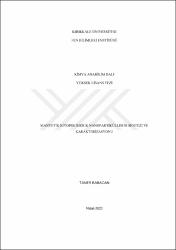| dc.contributor.advisor | Metin, Ayşegül Ülkü | |
| dc.contributor.author | Babacan, Taner | |
| dc.date.accessioned | 2021-01-16T19:07:57Z | |
| dc.date.available | 2021-01-16T19:07:57Z | |
| dc.date.issued | 2020 | |
| dc.identifier.uri | | |
| dc.identifier.uri | https://hdl.handle.net/20.500.12587/16343 | |
| dc.description | YÖK Tez ID: 630430 | en_US |
| dc.description.abstract | Bu tez çalışmasında, nano boyutta manyetik özellikteki kitosan-aşı-poli(glisidil metakrilat) partikülleri radikalik polimerizasyon yöntemi ile sentezlendi ve yapısal ve morfolojik özellikleri FTIR, SEM-EDS, VSM, XRD ve TGA yöntemleri ile aydınlatıdı. Daha sonra, manyetik özellikteki nanopartiküller iki farklı yol kullanılarak anyonik boyaların (RR-120 ve IC) giderilmesinde kullanıldı. İlk bölümde, manyetik nanopartikül yapısındaki fonksiyonel epoksi grubu 1,6-diaminohekzan kullanılarak amin gruplarına dönüştürüldü ve adsorpsiyon yolu ile anyonik boyaların uzaklaştırılmasında etkinliği araştırıldı. Adsorpsiyon kos¸ullarının (pH, adsorpsiyon denge su¨resi, iyonik s¸iddet, sıcaklık, bas¸langıc¸ boya deris¸imi gibi) manyetik nanopartiku¨llerin boyaları adsorplama performansına etkisi incelendi. Bununla birlikte, adsorpsiyon kinetigˆi ve izoterm modeli ile manyetik nano partiku¨llerin yeniden kullanılabilirligˆi gibi parametreler de belirlendi. Manyetik kitosan-aşı-poli(glisidil metakrilat) nanopartiküllerinin RR-120 ve IC için maksimum adsorpsiyon kapasiteleri sırası ile pH 5.0 ve 3.0'de 241 mg/g ve 185 mg/g olarak belirlendi. Manyetik nanopartiku¨llerin adsorpsiyon kapasitesinde o¨nemli bir azalma olmadan adsorpsiyon-desorpsiyon is¸lem do¨ngu¨lerinde yeniden kullanılabilir olduğu belirlendi. Tez c¸alıs¸masının ikinci bo¨lu¨mu¨nde, manyetik kitosan-aşı-poli(glisidil metakrilat) nanopartiküllerinin, mCHT-PGMA, epoksi grupları EDA kullanılarak amin gruplarına do¨nu¨s¸tu¨ru¨ldu¨. Lakkaz enzimi, GA kullanılarak kovalent bağlanma yöntemi ile immobilize edildi ve immobilize edilen enzim miktarı 70 ? 0,21 mg/g olarak hesaplandı. İmmobilize enzimin aktivitesine pH ve sıcaklık gibi parametrelerin etkisi belirlenerek, serbest enzim ile karşılaştırıldı ve lakkaz immobilize mCHT-PGMA nanoku¨releri RR-120 ve IC boyalarının giderilmesinde kullanıldı. Anahtar Kelimeler: Manyetik Nanopartikül, Kitosan, Aşı Kopolimer. | en_US |
| dc.description.abstract | In this thesis, nano-size magnetic chitosan-graft-poly (glycidyl methacrylate) particles were synthesized by radical polymerization method and determined structural and morphological properties by FTIR, SEM-EDS, VSM, XRD and TGA methods. Then, magnetic nanoparticles were used to remove anionic dyes (RR-120 and IC) using two different ways. In the first part, the functional epoxy groups of the magnetic nanoparticles were converted into amine groups using 1,6-diaminohexane and its effectiveness was investigated in removing anionic dyes by adsorption. The effect of adsorption conditions (such as pH, adsorption equilibrium time, ionic strenght, temperature, initial dye concentration) on adsorption performance of magnetic nanoparticles were examined. However, parameters such as adsorption kinetics and isotherm model and reusability of magnetic nanoparticles were also determined. Maximum adsorption capacities of magnetic chitosan-graft-poly (glycidyl methacrylate) nanoparticles for RR-120 and IC were determined as 241 mg /g and 185 mg/g at pH 5.0 and 3.0, respectively. It was determined that the magnetic nanoparticles can be reused in adsorption-desorption process cycles without a significant reduction in its adsorption capacity. In the second part of the thesis, magnetic chitosan-graft-poly (glycidylmethacrylate) nanoparticles, mCHT-PGMA, epoxy groups were converted into amine groups using EDA. The laccase enzyme was immobilized by the covalent bonding method using GA and the amount of immobilized enzyme was calculated to be 70 ±0.21 mg / g. The effect of parameters such as pH and temperature on the activity of the immobilized enzyme was determined and compared with the free enzyme. The laccase enzyme immobilized mCHT-PGMA nanoparticles was used to degrade RR-120 and IC dyes. Keywords: Magnetic Nanoparticles, Chitosan, Graft Copolymer. | en_US |
| dc.language.iso | tur | en_US |
| dc.publisher | Kırıkkale Üniversitesi | en_US |
| dc.rights | info:eu-repo/semantics/openAccess | en_US |
| dc.subject | Kimya | en_US |
| dc.subject | Chemistry | en_US |
| dc.subject | | en_US |
| dc.subject | | en_US |
| dc.subject | | en_US |
| dc.subject | | en_US |
| dc.subject | | en_US |
| dc.title | Manyetik biyopolimerik nanopartiküllerin sentezi ve karakterizasyonu | en_US |
| dc.title.alternative | Synthesis and characterization of magnetic biopolymeric nanoparticles | en_US |
| dc.type | masterThesis | en_US |
| dc.contributor.department | KKÜ, Fen Bilimleri Enstitüsü, Kimya Anabilim Dalı | en_US |
| dc.identifier.startpage | 1 | en_US |
| dc.identifier.endpage | 89 | en_US |
| dc.relation.publicationcategory | Tez | en_US |
















